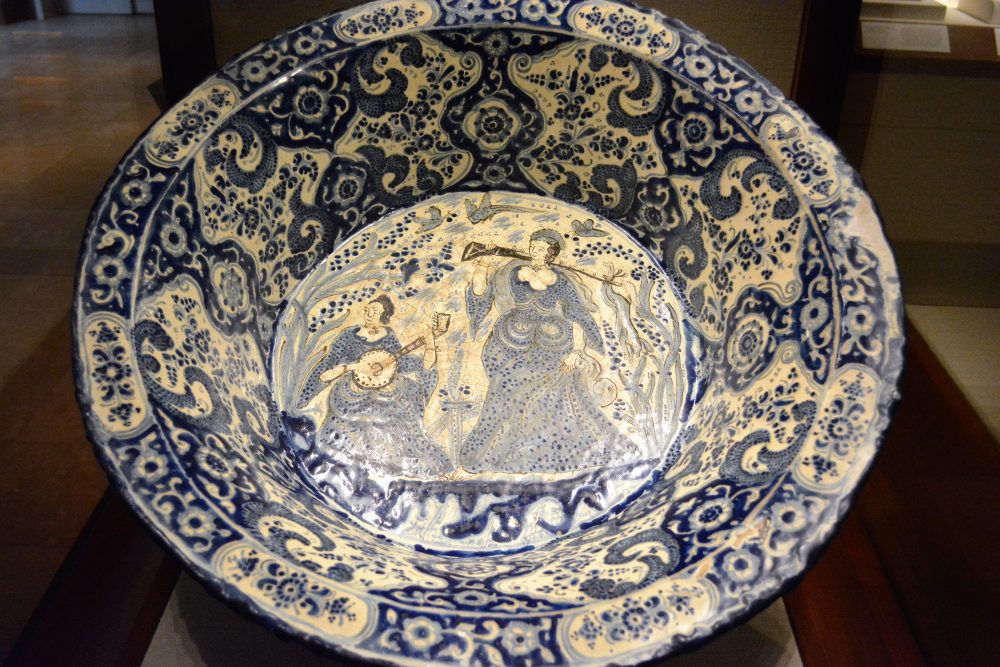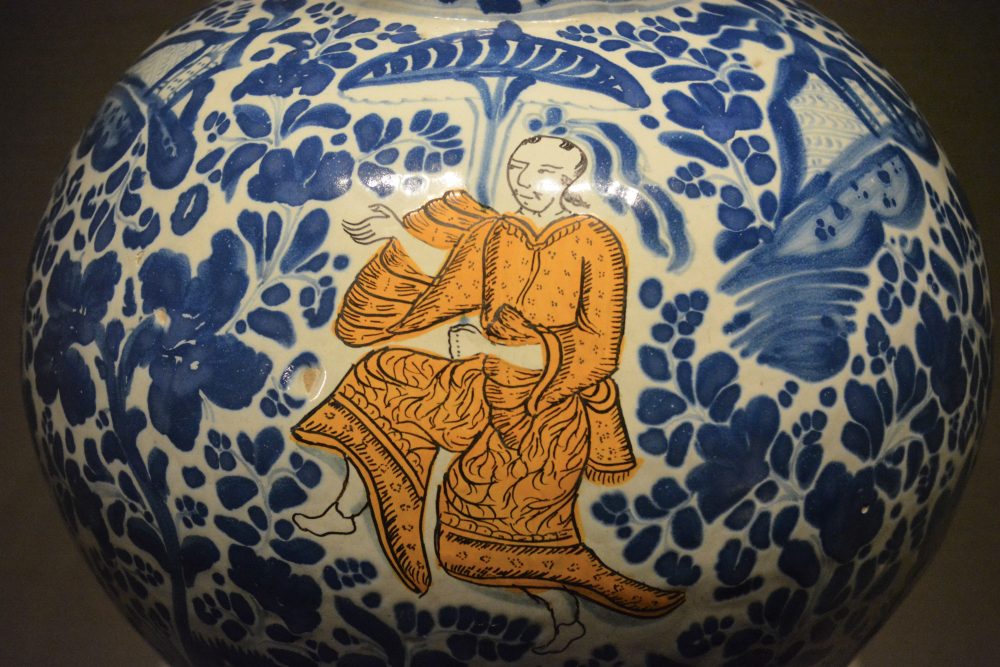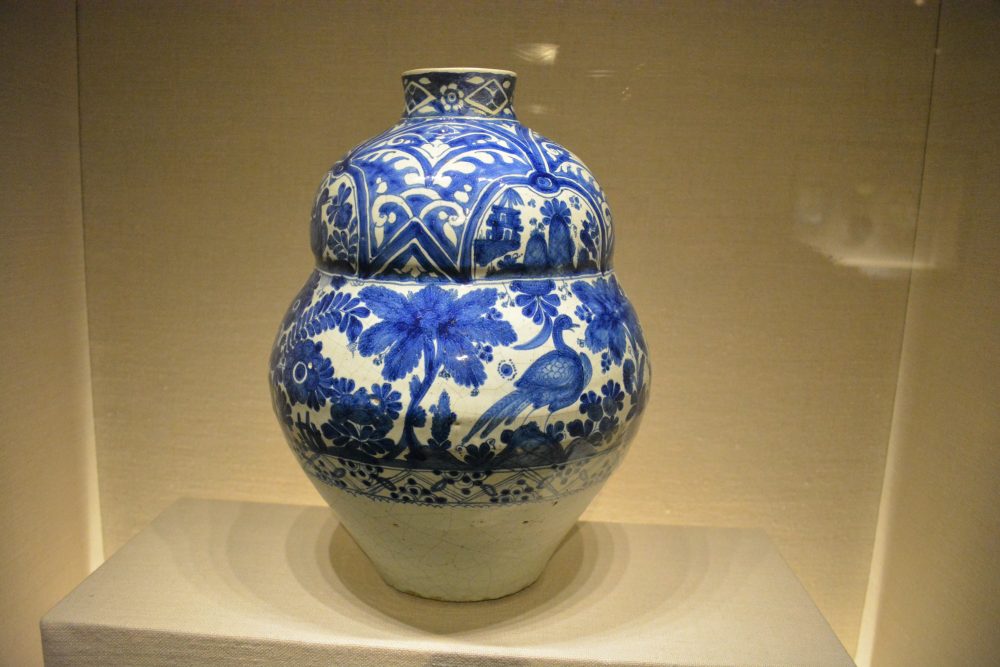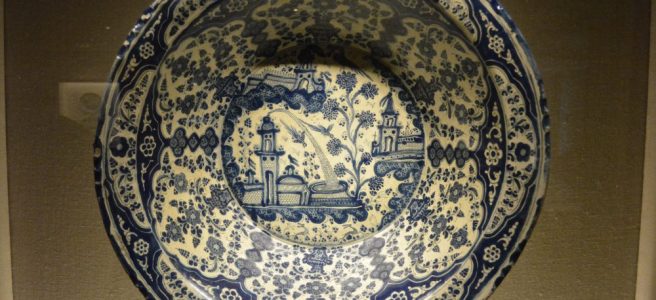Trade, race, and national identity are controversial topics nowadays. But seldom do they coalesce into one art form as seamlessly as in the Talavera exhibition at the Crow Collection of Asian Art in Dallas. “Clay Between Two Seas: From the Abbasid Court to Puebla de Los Angeles” explores Talavera pottery from its origin to its present, by dissecting a Mexican regional tradition through the lens of globalization.
Talavera pottery is a type of tin-glazed earthenware produced in and around Puebla, Mexico. Like in Jingdezhen of China, the access to high-quality resources (black and white clay from Amozoc and Tecali nearby) makes the city an ideal location for the pottery trade. During its golden age (from the mid-17th century to the mid-18th century), its technique and process were standardized and regulated by guilds of artisans. Local workshops almost went extinct after the Mexican War of Independence (1810-1821), but the form, rediscovered as cultural heritage, is now experiencing a revival.

Most of the ceramic work on display at the Crow comes from the colonial period, with supplementary examples from Iraq, Spain, and China for comparison. A large number of pieces are on loan from the Franz Mayer Museum in Mexico City.
The new world communicated with the old world through both an Atlantic route and later a Pacific route. In either route, Chinese porcelain was highly sought after by wealthy and royal patrons. Local artisans, influenced by both Hispano-Moresque ware and blue and white porcelain, aided their vocabulary. They are unique in their hybrid regional characteristics and regional preferences. In a nutshell — Talavera artisans with a technical lineage to Medieval Muslim potters, aspired to be Chinese, worked like the Spanish, but articulated their artistic expression in a language of their own.
The start of the golden period of Talavera pottery coincided with the fall of the Ming Dynasty (1644 AD). For much of the second half of the 17th century, Chinese export was at a complete halt because of a change in dynasties. It is possible that the decrease in supply through trade stimulated domestic demand. While potters had to adopt the chinoiserie shape and color scheme, demanded by regional preferences of the upper class, they nevertheless adapted the designs with distinct regional characteristics. That ambition is visible in the size of vessels – often so large that even a Chinese emperor could be jealous.
In fact, except in a few rare examples from Yuan Dynasty (when blue and white porcelain was invented), Chinese porcelain, especially from the late Ming Dynasty, was known for its delicacy rather than of volume. Talavera potters didn’t pursue the near-transparent lightness. My guess is that the indigenous clay material lacks the strength of Kaolin (the key ingredient for Chinese porcelain). Once liberated from concern about thickness, artisans in Puebla built in giant proportions. In the exhibition, one tall vase, in the form of Chinese garniture, may hold a small child or two. A few large basins, including one from the workshop of Diego Salvador Carreto, look almost ceremonial. Such basins have deep, flat bottoms but steep and flared walls. The near vertical wall indicates a metallic prototype and perhaps an origin more akin to Islamic than Chinese.

Despite their aspiration to Chinese craftsmanship, Talavera potters inherited their techniques from the old world, possibly even with some implants from Spain and Italy. The firing, at a much lower temperature, would only produce porous earthenware. The second firing with tin white glaze and cobalt blue makes vessels not only waterproof but also radiating with a satisfactory porcelain effect. In comparison, Chinese blue and white porcelain is one firing with cobalt blue covered under a transparent glaze. Early Talavera examples are mostly blue and white, but other colors like green, red and yellow entered the workshops around the 18th century. Techniques dictate the look and feel. One can easily spot the difference between Talavera pottery and Chinese porcelain. First, because the blue pigment is fused instead of vitrified in porcelain, the painting never reaches the sharpness, as seen in some best examples from the Kangxi period (1660-1722). Secondly, the opaque tin-oxide glaze lacks the luminosity and smoothness of porcelain. But whatever it may lack, potters compensated with a greater sense of immediacy and freedom, by applying blue pigment excessively. In some pieces, the blue paint is so thick that the near-embossed texture enlivens the whole surface.
Cobalt blue was not cheap. Precious cobalt, used in both Puebla and China, came from the same source: The Middle East. (In the waning years of the Ming Dynasty, cobalt blue was excavated from southern China, which, once fired, exhibited a grayish blue due to its lack of iron.) That excessiveness in blue pigment manifest, at least materialistically, the importance of a piece.
When it comes to painting, Talavera potters digested, digressed, and devised, with the artistic freedom to venture afar, as to the chagrin of their true sources.

First, the artisans had two conflicting “mentors”. The Islamic design emphasizes abstract geometric shapes tightly arranged symmetrically, under the principle of horror vacui (fear of empty decorative spaces). Chinese, on the other hand, preferred narratives in a non-symmetric setting. The white, seen as a cloud or water, plays an integral and important part in the pictorial rendering.
These pioneer potters decided to take a little bit of both. Dots or geometric elements were often painted near the neck or bottom of a vessel, while the center space is reserved for a more Chinese tradition. They probably took comfort in find out that early Kraakware from the Wanli period (1570-1620) had strictly defined panels of discrete imageries. They adopted such motifs and harmonized them with dotting techniques. Birds, rocks, and plants are of Chinese aesthetics. But often a close look reveals that artisans took the liberty to make the scene indigenous. (How would you expect to find a duck flying over cactus in a Chinese garden? Or is that a turkey beside a palm tree?)
The show coincides with an election stirred by rhetoric promoting nationalism, in the phrase of “America First”. apolitical as it may seem, Talavera Pottery states that cultural identities are sediments of innovation and development, through generations of both indigenous and foreign minds, all becoming possible when the world revolves into one global community. Sure, Chinese, Muslims, and Europeans all have left their marks on this pottery, so what? In the end, it is uniquely and truly Mexican.
Discover more from Urban Art & Antiques
Subscribe to get the latest posts sent to your email.


